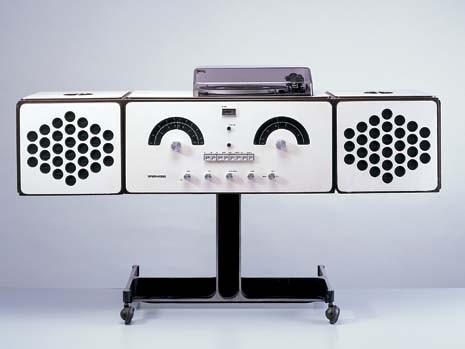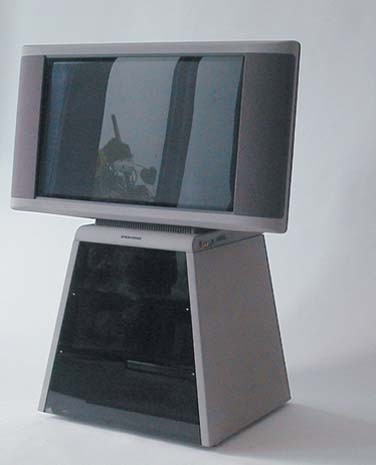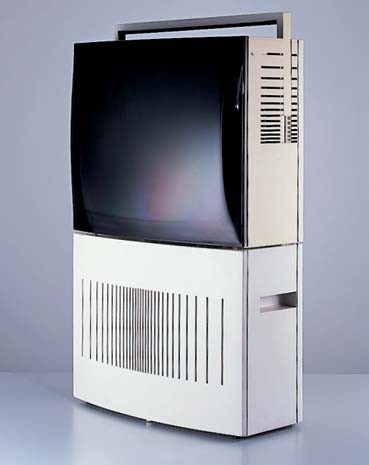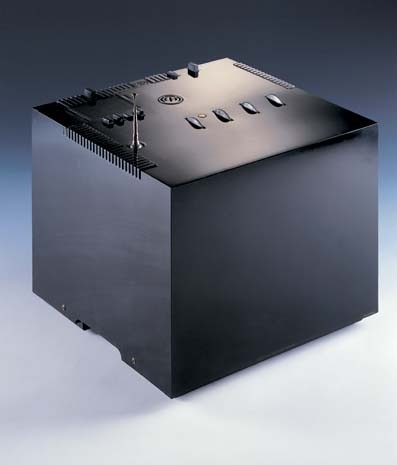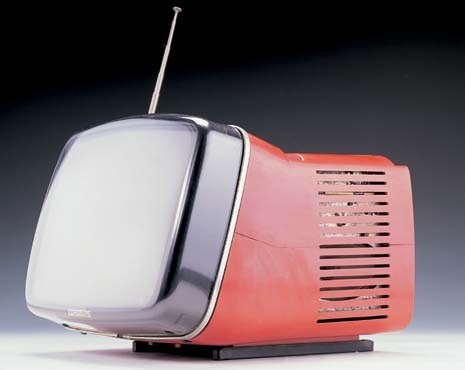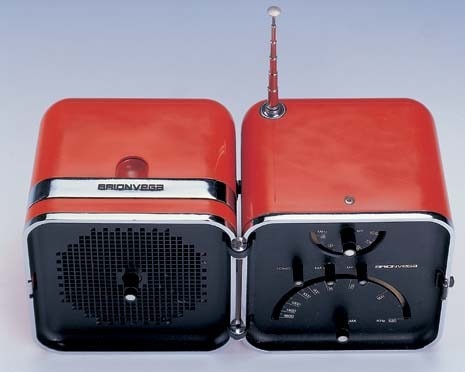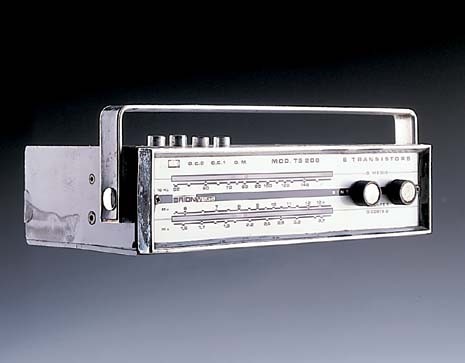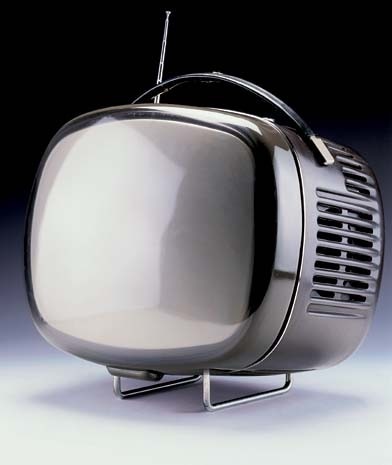You could write a telling history of Italian post-war industrial design almost entirely through the products of Brionvega and the decline of its once-unbeatable family-run business. At its best, Brion was able to work with the most gifted designers to create a whole stream of consumer electronics of remarkable charisma. They made stereo systems, radios and, above all, television sets. And they were among the first to realize that technology was not enough to create a successful product. Brionvega understood that merchandise needed a personality. Sadly, in recent years, it has followed the all too familiar path of Olivetti, Zanussi and others, either changing hands and passing into foreign ownership, as in the case of Zanussi, or losing its way entirely. Now in the hands of its third set of owners in a decade, Brionvega is trying once more to re-establish itself as a leading design manufacturer, a task that is growing increasingly difficult.
The television itself has managed to survive as a type thus far, even though most manufacturing is in Asia. But that could change, as laptops and personal digital assistants take on ever more functions. Brionvega’s biggest asset is its design pedigree. Last year the firm was able to become the first electronics company in history to reissue a two-decade-old product; its circuits were completely new, but such was the iconic power of its shape that this piece of nostalgia made complete sense, as if Apple were to reissue one of its original sit-up-and-beg Macs.
Brionvega reflects the creativity of Italian post-war enterprise, the radical step from radio to television and the success of Italian design worldwide, but also the burgeoning age of information. The company story is that of the Brion family: Giuseppe, the founder; his wife, Rina; and their son, Ennio, who directed Brionvega until its 1992 acquisition by the Seleco group, which was, in turn, taken over by Industrie Formenti in 1998. After working at Phonola and RadioMarelli, in 1945 Giuseppe Brion set up a company to manufacture wireless components. Originally called BPM, it later changed its name to Vega BP Radio when, to combat stiff American and German competition, the company started making finished products in 1950. Brion grasped television’s potential early on, and when the RAI network offered him a contract to publicize its services, he bought the Homelight television firm and changed its name to Radio Vega Televisione. In 1954 he brought out the first completely Italian TV set.
Brion was interested not only in systems technology but also in the design of the outer shell. In this way he encouraged the integration of the television into the domestic environment, making a consumer product rather than a technical appliance. Thus began a collaboration with many of Italy’s leading designers, including Rodolfo Bonetto, Franco Albini and Franca Helg, who designed the Cristallo 23 in 1959 and the beautiful Orion 23 two years later. The Orion’s lightness and delicacy contrasted sharply with the monolithic gravity of its German and American rivals. In the 1960s the business continued to expand, and its name was changed first to Brion Vega and finally, in 1963, to Brionvega. Its investment in design matured from an intuitive experiment to become the company’s main strength. In 1962 Marco Zanuso was joined by the German Richard Sapper, and together they created some of the Brionvega masterpieces: the Doney 14 television sets in 1962, the Algol 11 in 1964 and the Black 201 in 1969, which came with the TS502 radio. These were followed by the stereo set designed by Castiglioni in 1966 and the radio recorder RR 130 by Bellini in 1970.
The Doney not only looked great, it was a serious technological step forward, the first transistorized TV to be produced in Europe. Small and easy to carry, it fitted any interior, from the small apartment to the smart house. It helped transform the TV from a domestic altar rooted in the living room into an appliance that could migrate all over the house. It hardly seemed to belong to the same species as the valve-driven dinosaur sets of the period. Its tightly rounded forms (achieved by vacuum-forming its transparent plastic shell) served as a prelude to the explosion of Pop design in the 1960s and to experiments in new plastic technologies introduced in Italy by the economic boom.
Two years later, in 1964, the Algol came onto the market. This lilliputian TV with an 11-inch screen became an instant cult object of Italian design (to this day it is shown at MoMA in New York and at the Museum für Kunst und Gewerbe in Hamburg). Its harmonious and rational form, size, pop-up handle and tilted screen made it the perfect nomadic object. Leaping off the stand or legs that had previously corralled TV sets into a corner, Algol could sit on the floor. Zanuso compared it to a little dog looking up at its master. In those years very few makers could match the confidence of Brionvega’s approach to design. The secret of the firm’s success, however, lay in Giuseppe, Rina and Ennio Brion’s outstanding knack for linking the best Italian design with the most innovative electronic technologies. ‘It was wonderful working for Brion’, Achille Castiglioni recalls, ‘because a design group would be set up, where the technical side of the product, meaning also the client’s, was actually very close to that of the designer. This was design teamwork, the best attainable in these cases, because you have a relationship in which the situation in itself engenders a better design. The design quality is always better when the difficulties are bigger’.
After the mythic TS502 hinged radio cube of 1964, the Zanuso-Sapper team went on to design the Black ST 201 television, which went into production in 1969. With the Black, preference was given for the first time to reduced dimensions and characteristics like portability and versatility. In fact, this was the first TV set to make miniaturization the priority. The Black based its identity on the purity of its geometry, a black cube that appeared to integrate screen with case in an entirely seamless way. Here was abstraction concentrated in a surreal object whose image appeared and disappeared. By means of its transparent black reflecting cap, the television became a piece of furniture – admired almost more when turned off than when it was on. It was rechristened ‘the cube’ and was clearly an influence on Steve Jobs and his new computer. The technical side became an increasing challenge, as Sergio Asti, the designer of one of the earliest colour television sets (the Pally of 1974), remarks: ‘In the design of a TV set, the finished article must take into account the technical situation as an irrepressible datum, though certainly open to interpretation and possible changes.
The question is always how to add an aesthetic and expressive quality to the object by interpreting its technical and commercial necessities with the freest possible yet rigorous (aesthetic) conviction, as you would expect from an electrical appliance whose presence in the home is not solely related to ‘function’. Working for Brion was a unique experience. I could design and make practical developments, directly in the workshop, by inventing, discussing and modifying (for the better) what was proposed to me, like the good craftsman that I believe I am’. Asti’s TVC 3 Pally and, even more, his intelligent prototype of that period highlighted the sculptural quality of the set, demonstrated by the transverse cuts of the loudspeakers and the upper alignment of the controls, almost pictorial signs in the compact uniformity of the body surface. Starting from the Triangular 26 (a prototype of 1968), Bellini explored the avenues offered by geometry to bestow character and dignity on the television set.The triangular form was succeeded by the mono-block of the Aster 20 in 1968, the concavities of the Sider and the Volans in 1969 and the cubic surfaces of the Monitor 1 15 and the TVC Spot 15 in 1978, in which the absoluteness of the black is combined with the elegance of wood in accordance with the tendencies of the time. The minimalist rigour of these products tends to favour the versatile integration of the television with domestic furniture, at the same time enhancing its intrinsic aesthetic qualities. The quasi-abstract work of the 1970s gave way to the postmodern experiments of the 1980s. Brion commissioned Ettore Sottsass to design Memphis I in homage to the historic group. Only 100 units, which had a plastic laminate cladding, were produced, but the decorative euphoria did not last long.
The high-tech austerity of the line was soon re-established with the Coro Pansound television of 1983 and the Sintesi of 1988, designed by Lucci and Orlandini (pupils of Zanuso). The masterpiece of those years was, without a doubt, the Glass Cube, designed in 1992 by Bellini, who also did the Best (1990) and the Quadro 25 (1992). The Glass Cube revisited the design principles of Zanuso’s Black, but mitigated the compactness of its body by cladding it with glass panels on the five sides of the cube that contained the set. It is an object adaptable to any part of the house, asserting its presence by the reflected neutrality of its surface rather than pointless sensationalism. The result was a new emblem of the Brionvega philosophy. The Glass Cube, however, also marked the transfer of Brionvega to Seleco, which was subsequently bought by the Formenti group. Formenti has tried to renew the Brionvega tradition by directing, between 2001 and 2002, the technological rejuvenation of historic models such as the Algol, the Doney, the Glass Cube and the TS 522 radio, remade in the same form but with updated electronics. ‘We are not Sony’, says Giovanni Formenti, the group’s managing director. ‘We don’t invent technology but we do apply it. Brionvega is our spearhead brand name and, like the Brion family, we are going to invest in design with the object of recapturing a corner of the global market’. With this end in view, Formenti has commissioned two new television sets from Mario Bellini, which it hopes will represent a new direction for Brionvega, while still maintaining its essential DNA. The plan is to launch Doge later this year, and, Teatro a home cinema system, next year. True to Brionvega’s traditions, both are intended not to impose on their surroundings, but to merge with them. According to Bellini the television will in future reduce in mass. Its design will emphasise instead that slim stratum of images and sounds that as the interface for a multimedia system will be increasingly part of our lives, representing information, education and entertainment at home. Special thanks to Centro Studi Archivio della Comunicazione, Università di Parma and to Spazio 900 di Milano
